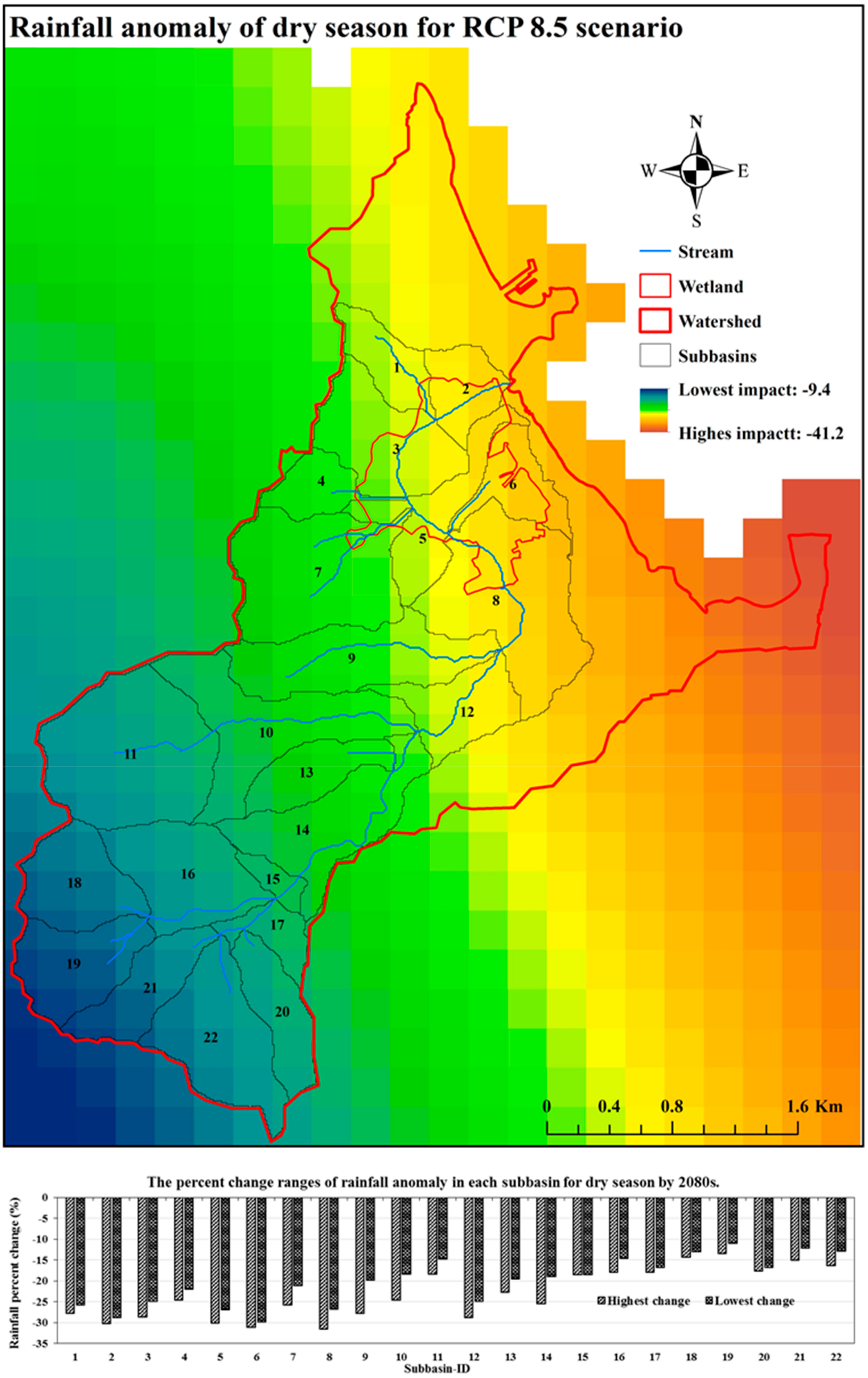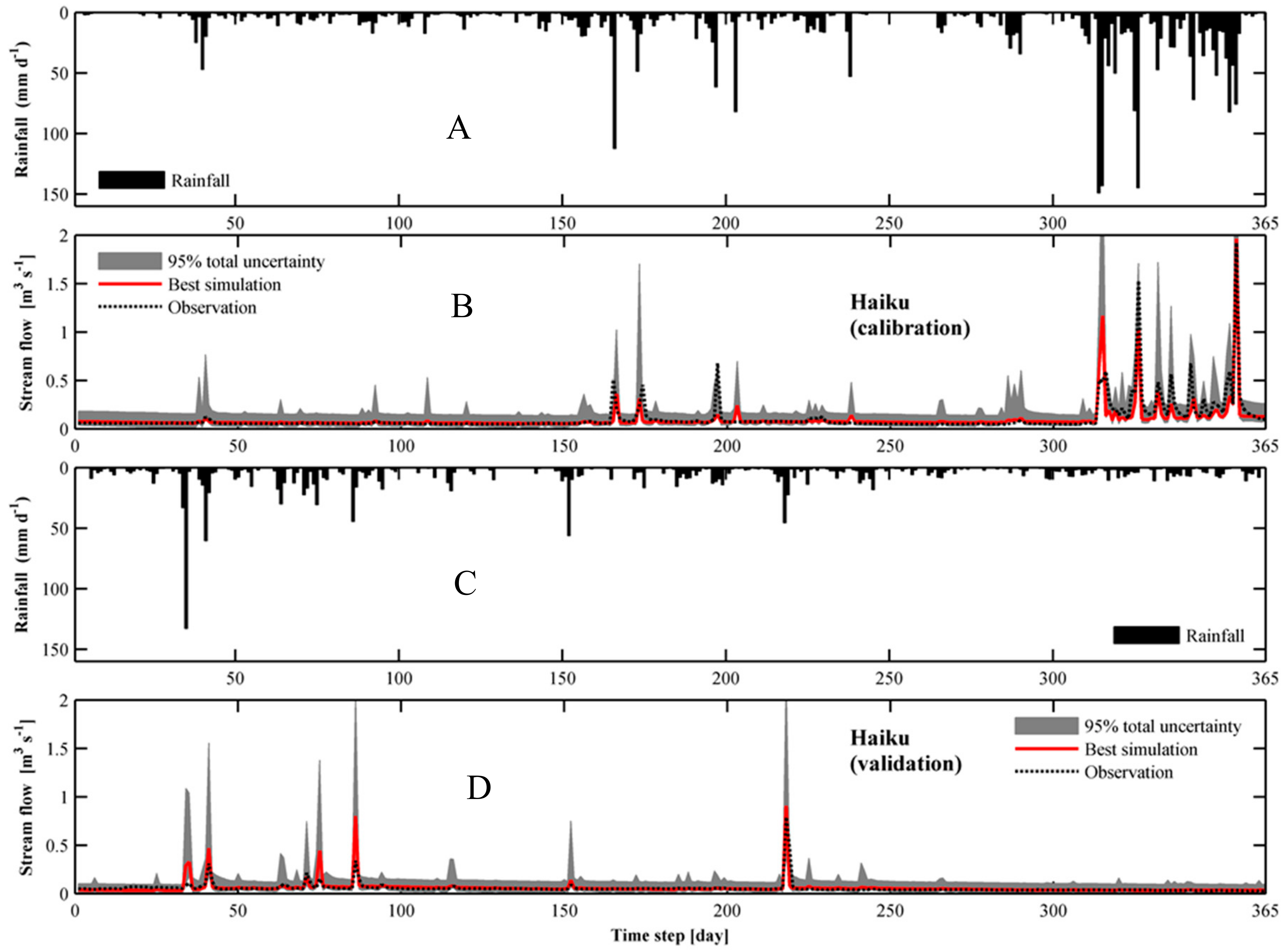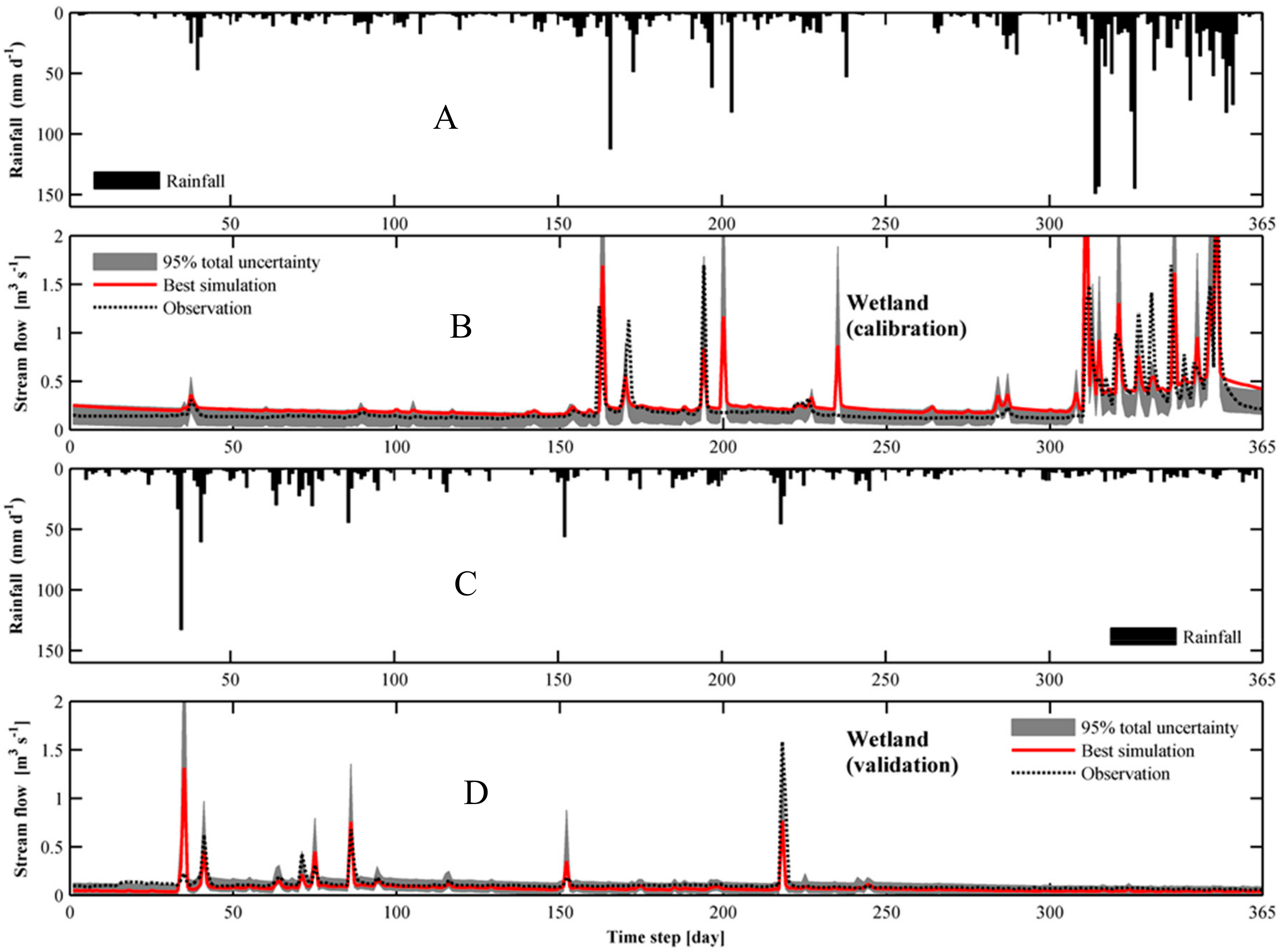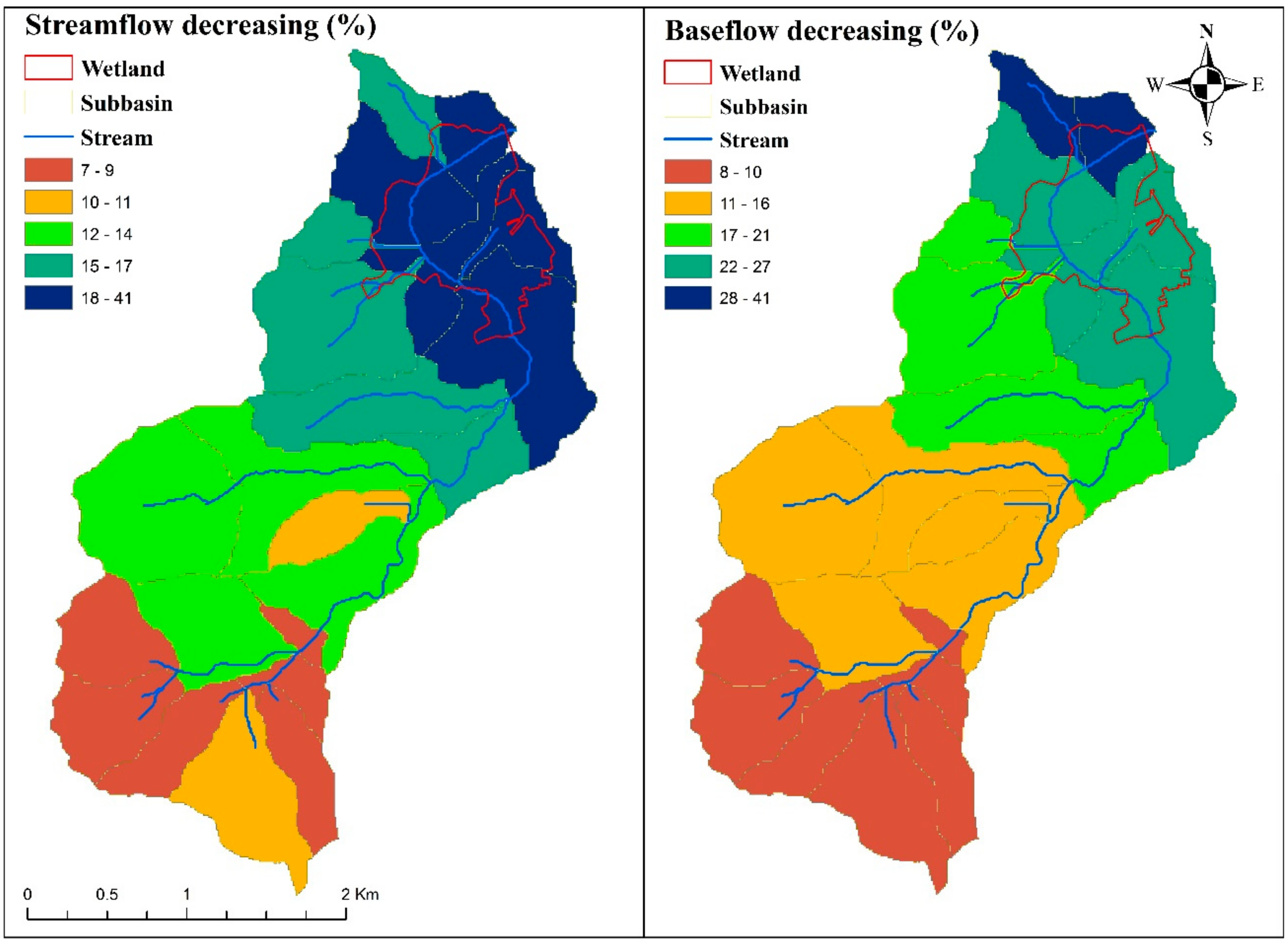Assessment of Wetland Restoration and Climate Change Impacts on Water Balance Components of the Heeia Coastal Wetland in Hawaii
Abstract
:1. Introduction
2. Materials and Methods
2.1. Study Area
2.2. Hydrological Modeling
2.3. Climate Change Scenarios
2.4. Land Use Change Scenario
3. Results and Discussion
3.1. SA and Streamflow Simulation
3.2. Impacts of LUC on WBCs
3.3. Impacts of CC on WBCs
3.4. Combined Effects of CC and LUC on WBCs
4. Conclusions
Author Contributions
Funding
Acknowledgments
Conflicts of Interest
References
- Dale, V.H. The relationship between land-use change and climate change. Ecol. Appl. 1997, 7, 753–769. [Google Scholar] [CrossRef]
- Loveland, T.; Mahmood, R.; Patel-Weynand, T.; Karstensen, K.; Beckendorf, K.; Bliss, N.; Carleton, A. National Climate Assessment Technical Report on the Impacts of Climate and Land Use and Land Cover Change; US Geological Survey: Reston, VA, USA, 2012; pp. 1–87.
- Benning, T.L.; LaPointe, D.; Atkinson, C.T.; Vitousek, P.M. Interactions of climate change with biological invasions and land use in the hawaiian islands: Modeling the fate of endemic birds using a geographic information system. Proc. Natl. Acad. Sci. USA 2002, 99, 14246–14249. [Google Scholar] [CrossRef]
- Leta, O.T.; El-Kadi, A.I.; Dulai, H.; Ghazal, K.A. Assessment of SWAT Model Performance in Simulating Daily Streamflow under Rainfall Data Scarcity in Pacific Island Watersheds. Water 2018, 10, 1533. [Google Scholar] [CrossRef]
- Ghazal, K.A.; Leta, O.T.; El-Kadi, A.I.; Dulai, H. Quantifying Dissolved Silicate Fluxes across Heeia Shoreline in Hawaii via Integrated Hydrological Modeling Approach. Univers. J. Geosci. 2018, 6, 147–156. [Google Scholar] [CrossRef]
- Leta, O.T.; El-Kadi, A.I.; Dulai, H.; Ghazal, K.A. Assessment of climate change impacts on water balance components of Heeia watershed in Hawaii. J. Hydrol. Reg. Stud. 2016, 8, 182–197. [Google Scholar] [CrossRef] [Green Version]
- Choi, W.; Pan, F.; Wu, C. Impacts of climate change and urban growth on the streamflow of the milwaukee river (wisconsin, USA). Reg. Environ. Change 2017, 17, 889–899. [Google Scholar] [CrossRef]
- Psaris, M.; Chang, H. Assessing the impacts of climate change, urbanization, and filter strips on water quality using SWAT. Int. J. Geosp. Environ. Res. 2014, 1, 1. [Google Scholar]
- Safeeq, M.; Grant, G.; Lewis, S.; Nolin, A.; Hempel, L.; Cooper, M.; Tague, C. Integrated snow and hydrology modeling for climate change impact assessment in oregon cascades. In Proceedings of the AGU Fall Meeting, San Francisco, CA, USA, 15–19 December 2014. [Google Scholar]
- Pervez, M.S.; Henebry, G.M. Assessing the impacts of climate and land use and land cover change on the freshwater availability in the Brahmaputra River basin. J. Hydrol. Reg. Stud. 2015, 3, 285–311. [Google Scholar] [CrossRef] [Green Version]
- Xie, S.-P.; Okumura, Y.; Miyama, T.; Timmermann, A. Influences of Atlantic Climate Change on the Tropical Pacific via the Central American Isthmus*. J. Clim. 2008, 21, 3914–3928. [Google Scholar] [CrossRef]
- Keener, V. Climate Change and Pacific Islands: Indicators and Impacts: Report for the 2012 Pacific Islands Regional Climate Assessment; Island Press: Washington, DC, USA, 2013. [Google Scholar]
- Erwin, K.L. Wetlands and global climate change: The role of wetland restoration in a changing world. Wetl. Ecol. Manag. 2009, 17, 71–84. [Google Scholar] [CrossRef]
- Paul, S.; Küsel, K.; Alewell, C. Reduction processes in forest wetlands: Tracking down heterogeneity of source/sink functions with a combination of methods. Soil Boil. Biochem. 2006, 38, 1028–1039. [Google Scholar] [CrossRef]
- Root, T.L.; Price, J.T.; Hall, K.R.; Schneider, S.H.; Rosenzweig, C.; Pounds, J.A. Fingerprints of global warming on wild animals and plants. Nat. Cell Boil. 2003, 421, 57–60. [Google Scholar] [CrossRef]
- Pritchard, D. Wise Use of Wetlands: Concepts and Approaches for the Wise Use of Wetlands. In Ramsar Handbooks for the Wise Use of Wetlands, 4th ed.; Ramsar Convention Secretariat: Gland, Switzerland, 2010. [Google Scholar]
- Oki, D.S. Geohydrology of the Central Oahu, Hawaii, Ground-Water Flow System and Numerical Simulation of the Effects of Additional Pumping; U.S. Geological Survey: Honolulu, HI, USA, 1998.
- Eversole, D.; Andrews, A. Climate Change Impacts in Hawai‘i: A Summary of Climate Change and Its Impacts to Hawaíís Ecosystems and Communities; University of Hawaii Sea Grant College Program: Honolulu, HI, USA, 2014. [Google Scholar]
- Safeeq, M.; Fares, A. Hydrologic response of a hawaiian watershed to future climate change scenarios. Hydrol. Process. 2012, 26, 2745–2764. [Google Scholar] [CrossRef]
- Timm, O.E.; Giambelluca, T.W.; Diaz, H.F. Statistical downscaling of rainfall changes in Hawai‘i based on the cmip5 global model projections. J. Geophys. Res. Atmos. 2015, 120, 92–112. [Google Scholar]
- Rotzoll, K.; Fletcher, C.H. Assessment of groundwater inundation as a consequence of sea-level rise. Nat. Clim. Change 2013, 3, 477–481. [Google Scholar] [CrossRef]
- Leta, O.T.; El-Kadi, A.I.; Dulai, H. Implications of Climate Change on Water Budgets and Reservoir Water Harvesting of Nuuanu Area Watersheds, Oahu, Hawaii. J. Water Resour. Plan. Manag. 2017, 143, 5017013. [Google Scholar] [CrossRef]
- Bassiouni, M.; Oki, D.S. Trends and shifts in streamflow in Hawai‘i, 1913–2008. Hydrol. Process. 2013, 27, 1484–1500. [Google Scholar] [CrossRef]
- Timm, O.; Díaz, H.F. Synoptic-Statistical Approach to Regional Downscaling of IPCC Twenty-First-Century Climate Projections: Seasonal Rainfall over the Hawaiian Islands*. J. Clim. 2009, 22, 4261–4280. [Google Scholar] [CrossRef]
- Wild, M. Enlightening Global Dimming and Brightening. Am. Meteorol. Soc. 2012, 93, 27–37. [Google Scholar] [CrossRef] [Green Version]
- Longman, R.J.; Giambelluca, T.W.; Alliss, R.J.; Barnes, M.L. Temporal solar radiation change at high elevations in Hawai‘i. J. Geophys. Res. Atmos. 2014, 119, 6022–6033. [Google Scholar] [CrossRef] [Green Version]
- Pandey, B.K.; Gosain, A.; Paul, G.; Khare, D. Climate change impact assessment on hydrology of a small watershed using semi-distributed model. Appl. Water Sci. 2017, 7, 2029–2041. [Google Scholar] [CrossRef]
- Jha, M. Impacts of climate change on streamflow in the Upper Mississippi River Basin: A regional climate model perspective. J. Geophys. Res. Biogeosciences 2004, 109, 109. [Google Scholar] [CrossRef]
- Sahoo, G.; Ray, C.; De Carlo, E. Calibration and validation of a physically distributed hydrological model, MIKE SHE, to predict streamflow at high frequency in a flashy mountainous Hawaii stream. J. Hydrol. 2006, 327, 94–109. [Google Scholar] [CrossRef]
- Oki, D.S. Numerical Simulation of the Effects of Low-Permeability Valley-Fill Barriers and the Redistribution of Ground-Water Withdrawals in the Pearl Harbor Area, Oahu, Hawaii; Department of the Interior, U.S. Geological Survey: Denver, CO, USA, 2005.
- Takasaki, K.; Hirashima, G.T.; Lubke, E. Water Resources of Windward Oahu, Hawaii; U.S. Government Publishing Office: Washington, DC, USA, 1969.
- Kailua Bay Advisory Council. Ko’olaupoko Watershed Restoration Action Strategy Kailua Bay Advisory Council (kbac); Hawaii’s Department of Health: Honolulu, HI, USA, 2007.
- Kakoo Oiwi. Heeia Wetlands Restoration; Käkoÿo ÿÖiwi: Käneÿohe, HI, USA, 2011; file no. POH-00159.
- Izuka, S.K.; Hill, B.R.; Shade, P.J.; Tribble, G.W. Geohydrology and Possible Transport Routes of Polychlorinated Biphenyls in Haiku Valley, Oahu, Hawaii. In Geohydrology and Possible Transport Routes of Polychlorinated Biphenyls in Haiku Valley, Oahu, Hawaii; US Geological Survey: Reston, VA, USA, 1993. [Google Scholar]
- Hunter, C.L.; Evans, C.W. Coral reefs in kaneohe bay, Hawaii: Two centuries of western influence and two decades of data. B. Mar. Sci. 1995, 57, 501–515. [Google Scholar]
- Bantilan-Smith, M.; Bruland, G.L.; MacKenzie, R.A.; Henry, A.R.; Ryder, C.R. A comparison of the vegetation and soils of natural, restored, and created coastal lowland wetlands in Hawai‘i. Wetlands 2009, 29, 1023–1035. [Google Scholar] [CrossRef]
- Bankoff, G. Winds of Colonisation: The Meteorological Contours of Spain’s Imperium in the Pacific 1521-1898. Environ. Hist. 2006, 12, 65–88. [Google Scholar] [CrossRef]
- Carlquist, S. Geology, Climate, Native Flora and Fauna Above the Shoreline. In Hawaii: A Natural History; Nat’l Tropical Botanical Garden: Lawai, Kauai, HI, USA, 1980; Volume 6. [Google Scholar]
- Arnold, J.; Kiniry, J.; Srinivasan, R.; Williams, J.; Haney, E.; Neitsch, S. Soil and Water Assessment Tool Input/Output File Documentation: Version 2012; US Department of Agriculture–Agricultural Research Service, Grassland, Soil and Water Research Laboratory and Blackland Research and Extension Center, Texas AgriLife Research: Temple, TX, USA, 2012.
- Gassman, P.W.; Reyes, M.R.; Green, C.H.; Arnold, J.G. The Soil and Water Assessment Tool: Historical Development, Applications, and Future Research Directions. Trans. ASABE 2007, 50, 1211–1250. [Google Scholar] [CrossRef] [Green Version]
- Abbaspour, K.C.; Yang, J.; Maximov, I.; Siber, R.; Bogner, K.; Mieleitner, J.; Zobrist, J.; Srinivasan, R. Modelling hydrology and water quality in the pre-alpine/alpine Thur watershed using SWAT. J. Hydrol. 2007, 333, 413–430. [Google Scholar] [CrossRef]
- Van Liew, M.W.; Arnold, J.G.; Bosch, D.D. Problems and potential of autocalibrating a hydrologic model. Trans. ASAE 2005, 48, 1025–1040. [Google Scholar] [CrossRef]
- Australian Bureau of Meteorology; CSIRO. Climate Change in the Pacific: Scientific Assessment and New Research, Volume 1: Regional Overview. Available online: https://www.pacificclimatechangescience.org/wp-content/uploads/2013/08/Climate-Change-in-the-Pacific.-Scientific-Assessment-and-New-Research-Volume-1.-Regional-Overview.pdf (accessed on 13 May 2019).
- Kakoo Oiwi. Heeia Wetland Restoration Strategic Plan 2010–2015; Kakoo Oiwi: Käneÿohe, HI, USA, 2010; p. 16.
- Shih, S.F.; Snyder, G.H. Leaf Area Index and Dry Biomass of Taro1. Agron. J. 1984, 76, 750. [Google Scholar] [CrossRef]
- Miyasaka, S.C.; Ogoshi, R.M.; Tsuji, G.Y.; Kodani, L.S. Site and Planting Date Effects on Taro Growth. Agron. J. 2003, 95, 545. [Google Scholar] [CrossRef]
- Arnold, J.G.; Moriasi, D.N.; Gassman, P.W.; Abbaspour, K.C.; White, M.J.; Srinivasan, R.; Santhi, C.; Harmel, R.D.; Van Griensven, A.; Van Liew, M.W.; et al. SWAT: Model Use, Calibration, and Validation. Trans. ASABE 2012, 55, 1491–1508. [Google Scholar] [CrossRef]
- Shih, S.F.; Snyder, G.H. Leaf Area Index and Evapotranspiration of Taro1. Agron. J. 1985, 77, 554–556. [Google Scholar] [CrossRef]
- Moriasi, D.N.; Arnold, J.G.; Van Liew, M.W.; Bingner, R.L.; Harmel, R.D.; Veith, T.L. Model Evaluation Guidelines for Systematic Quantification of Accuracy in Watershed Simulations. Trans. ASABE 2007, 50, 885–900. [Google Scholar] [CrossRef]
- Ndomba, P.; Mtalo, F.; Killingtveit, A. SWAT model application in a data scarce tropical complex catchment in Tanzania. Phys. Chem. Earth, Parts A/B/C 2008, 33, 626–632. [Google Scholar] [CrossRef]
- Uchida, J.; Levin, P.; Miyasaka, S.; Teves, G.; Hollyer, J.; Nelson, S.; Ooka, J. Taro Mauka to Makai: A Taro Production and Business Guide for Hawai‘i Growers; University of Hawaii: Honolulu, HI, USA, 2008. [Google Scholar]








| Variable Name | Code and Values | Definition | Reference |
|---|---|---|---|
| ICNUM | 142 | Land cover/plant code | This study |
| CPNM | TARO | Four-character code of land name | This study |
| IDC | 6 | Herbaceous perennial crop code | [39,46,47] |
| CROPNAME | Wetland Taro | Name of flooded taro | This study |
| BIO_E | 47 | Radiation-use efficiency of herbaceous | [39,47] |
| HVSTI | 0.01 | Harvest index for optimal growth | [45] |
| BLAI | 2.5 | Maximum potential leaf area index (LAI) | [48] |
| FRGRW1 | 0.11 | Fraction of the plant growing season | [39] |
| LAIMX1 | 0.13 | Fraction of the maximum LAI (first point) | [45] |
| FRGRW2 | 0.24 | Fraction of the plant growing season | [45] |
| LAIMX2 | 0.91 | Fraction of the maximum LAI (second point) | [39,45] |
| DLAI | 0.89 | Fraction of growing season (decline leaf area) | [39,45] |
| CHTMX | 0.7 | Maximum canopy height (meter) | This study |
| RDMX | 0.6 | Maximum root depth (meter) | This study |
| T_OPT | 25 | Optimal temperature for plant growth (°C) | This study |
| T_BASE | 21 | Minimum temperature for plant growth (°C) | This study |
| Parameter | t-Stat | p-Value | Parameter | t-Stat | p-Value |
|---|---|---|---|---|---|
| CN2 | −50.73 | 0 | SURLAG | 1.289 | 0.198 |
| CH_K2 | 34.071 | 0 | OV_N | −1.031 | 0.303 |
| ALPHA_BF | −16.563 | 0 | EPCO | 0.992 | 0.322 |
| CH_N2 | 6.242 | 0 | GW_DELAY | −0.686 | 0.493 |
| LAT_TTIME | 4.145 | 0 | SLSUBBSN | 0.677 | 0.499 |
| SOL_K | 2.69 | 0.007 | SLSOIL | 0.647 | 0.518 |
| GWQMN | 2.564 | 0.011 | HRU_SLP | 0.617 | 0.537 |
| RCHRG_DP | −1.805 | 0.72 | REVAPMN | 0.505 | 0.614 |
| ESCO | −1.672 | 0.095 | GW_REVAP | −0.327 | 0.744 |
| SOL_AWC | 1.496 | 0.135 | SOIL_Z | −0.299 | 0.765 |
| CANMX | 1.411 | 0.159 |
| Parameter | Description | Unit | Range | Calibrated | ||
|---|---|---|---|---|---|---|
| Minimum | Maximum | Haiku | Wetland | |||
| ALPHA_BF | Baseflow factor | day−1 | 0 | 0.005 | 3 × 10−4 | 0.0045 |
| CANMX | Maximum canopy storage | mm | −0.4 | 0.4 | 0.1 | −0.3 |
| CH_K2 | Effective hydraulic conductivity in main channel | mm h−1 | 10 | 50 | 39 | 20.4 |
| CH_N2 | Channel Manning’s roughness coefficient | 0.02 | 0.07 | 0.02 | 0.04 | |
| CN2 | Curve number at moisture condition II | −0.5 | 0.1 | −0.49 | −0.47 | |
| ESCO | Soil evaporation compensation factor | 0.5 | 1 | 0.9 | 0.5 | |
| LAT_TIME | Lateral flow travel time | day−1 | 10 | 90 | 81 | 18 |
| RCHRG_DP | Groundwater recharge to deep aquifer | 0 | 0.05 | 0.045 | 0.0002 | |
| GWQMN | Minimum depth for groundwater flow occurrence | mm | 1 | 1000 | 137 | 774.5 |
| SOL_K | Saturated soil hydraulic conductivity | mm h−1 | −0.5 | 0.1 | −0.4 | −0.03 |
| SOL_AWC | Soil water available capacity | −0.2 | 0.3 | −0.03 | 0.16 | |
| SURLAG | Surface runoff lag coefficient | day−1 | 0.5 | 2.5 | 1 | |
| Station | Period | Time Span | NSE | PBIAS (%) | RSR | r | P-factor | R-factor |
|---|---|---|---|---|---|---|---|---|
| Haiku | Calibration | 2002–2008 | 0.60 | 4.60 | 0.66 | 0.69 | 0.96 | 1.36 |
| Validation | 2009–2014 | 0.51 | 8.00 | 0.70 | 0.54 | 0.96 | 0.89 | |
| Wetland | Calibration | 2002–2008 | 0.51 | 13.00 | 0.63 | 0.67 | 0.81 | 0.81 |
| Validation | 2009–2014 | 0.50 | −2.59 | 0.67 | 0.50 | 0.95 | 0.67 |
| Season | Rainfall | Streamflow | Runoff | Lateralflow | Baseflow | Recharge | Soil Moisture | ET | PET |
|---|---|---|---|---|---|---|---|---|---|
| wet | 0.00 | 19.22 | 80.95 | 40.78 | −42.07 | −41.42 | 24.01 | −4.29 | −0.27 |
| dry | 0.00 | −12.17 | 13.32 | 85.22 | −41.37 | −43.07 | 57.49 | 5.54 | 0.26 |
| Scenario | Season | Rainfall | Streamflow | Runoff | Lateralflow | Baseflow | Recharge | Soil Moisture | ET | PET |
|---|---|---|---|---|---|---|---|---|---|---|
| Midmax 4.5 | wet | −3.47 | −10.53 | −7.41 | −5.15 | −18.94 | −12.11 | −7.83 | −1.86 | 2.71 |
| dry | −22.52 | −19.37 | −33.11 | −29.15 | −14.87 | −64.44 | −20.94 | −16.68 | 5.98 | |
| Midmax 8.5 | wet | −1.64 | −10.22 | −5.59 | −4.63 | −19.75 | −12.55 | −8.77 | 1.01 | 3.79 |
| dry | −20.20 | −19.10 | −30.63 | −25.40 | −15.83 | −68.16 | −21.64 | −14.61 | 6.30 | |
| Latemin 4.5 | wet | −4.77 | −14.84 | −11.20 | −8.19 | −25.12 | −18.45 | −10.74 | −0.09 | 3.79 |
| dry | −18.22 | −22.47 | −28.70 | −23.97 | −21.21 | −66.95 | −21.65 | −14.10 | 6.30 | |
| Latemin 8.5 | wet | −4.16 | −16.64 | −11.30 | −8.65 | −29.53 | −20.84 | −13.73 | 0.04 | 4.81 |
| dry | −30.05 | −28.98 | −44.47 | −37.06 | −24.68 | −84.61 | −31.25 | −22.46 | 8.72 |
| Scenario | Season | Rainfall | Streamflow | Runoff | Lateral Flow | Baseflow | Recharge | Soil Moisture | ET | PET |
|---|---|---|---|---|---|---|---|---|---|---|
| LUs2_Midmax 4.5 | wet | −4.15 | 4.60 | 57.72 | 28.03 | −54.19 | −50.57 | 13.54 | −4.80 | 2.30 |
| dry | −14.63 | −28.89 | −16.64 | 51.68 | −51.82 | −73.63 | 32.22 | −4.01 | 4.15 | |
| LUs2_Midmax 8.5 | wet | −4.15 | 4.60 | 57.72 | 28.03 | −54.19 | −50.57 | 13.54 | −4.80 | 2.30 |
| dry | −14.63 | −28.89 | −16.64 | 51.68 | −51.82 | −73.63 | 32.22 | −4.01 | 4.15 | |
| LUs2_Latemin 4.5 | wet | −4.77 | 1.38 | 52.54 | 25.16 | −56.75 | −52.52 | 11.00 | −3.92 | 3.22 |
| dry | −18.22 | −32.73 | −24.11 | 43.72 | −54.06 | −80.57 | 24.98 | −7.08 | 6.54 | |
| LUs2_Latemin 8.5 | wet | −4.16 | −1.12 | 50.21 | 22.49 | −59.13 | −53.70 | 7.32 | −3.06 | 4.14 |
| dry | −30.05 | −39.78 | −41.95 | 22.98 | −56.00 | −91.59 | 13.95 | −15.31 | 8.97 |
© 2019 by the authors. Licensee MDPI, Basel, Switzerland. This article is an open access article distributed under the terms and conditions of the Creative Commons Attribution (CC BY) license (http://creativecommons.org/licenses/by/4.0/).
Share and Cite
Ghazal, K.A.; Leta, O.T.; El-Kadi, A.I.; Dulai, H. Assessment of Wetland Restoration and Climate Change Impacts on Water Balance Components of the Heeia Coastal Wetland in Hawaii. Hydrology 2019, 6, 37. https://doi.org/10.3390/hydrology6020037
Ghazal KA, Leta OT, El-Kadi AI, Dulai H. Assessment of Wetland Restoration and Climate Change Impacts on Water Balance Components of the Heeia Coastal Wetland in Hawaii. Hydrology. 2019; 6(2):37. https://doi.org/10.3390/hydrology6020037
Chicago/Turabian StyleGhazal, Kariem A., Olkeba Tolessa Leta, Aly I. El-Kadi, and Henrietta Dulai. 2019. "Assessment of Wetland Restoration and Climate Change Impacts on Water Balance Components of the Heeia Coastal Wetland in Hawaii" Hydrology 6, no. 2: 37. https://doi.org/10.3390/hydrology6020037







